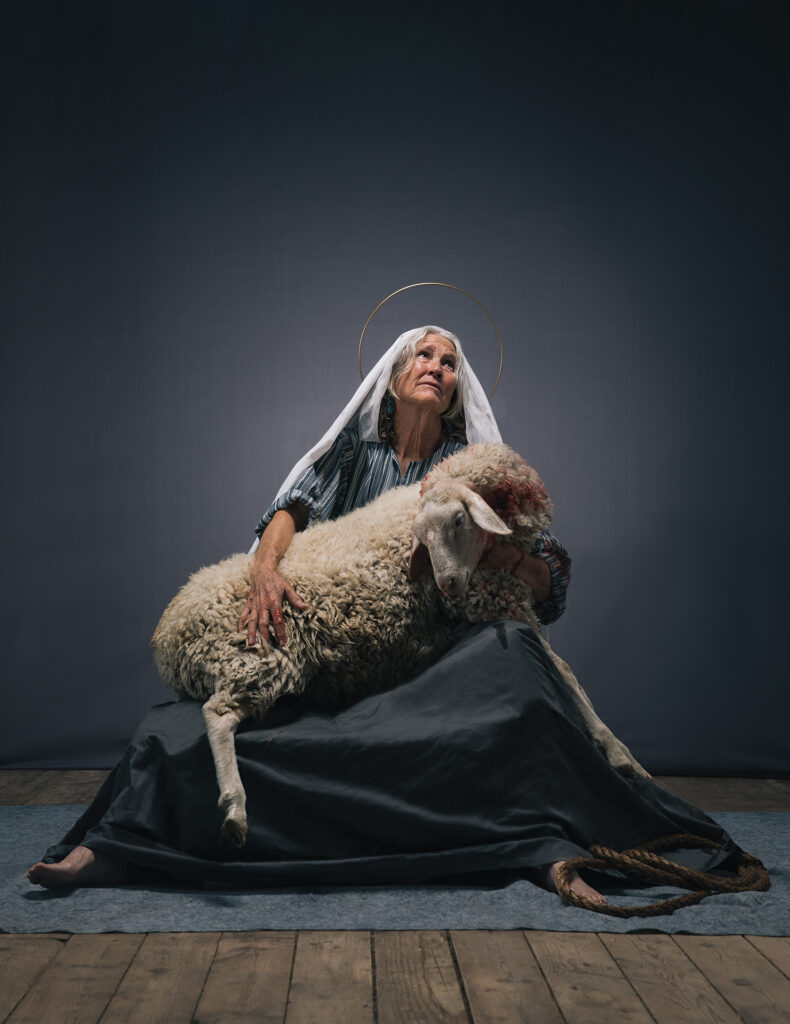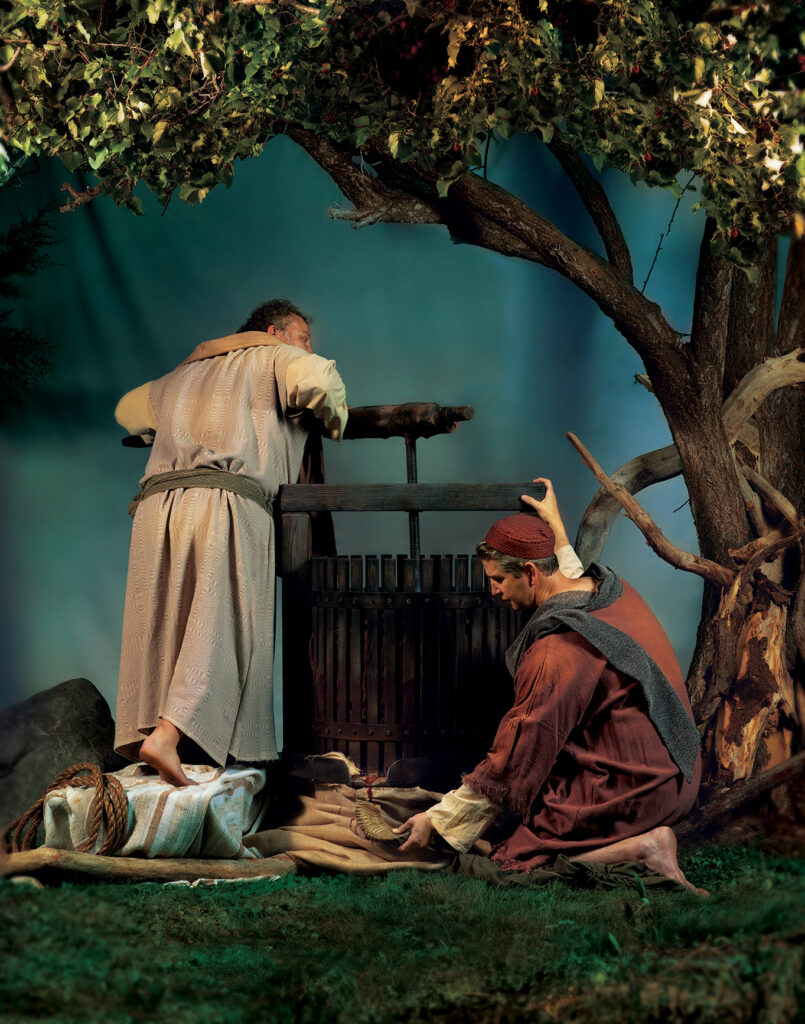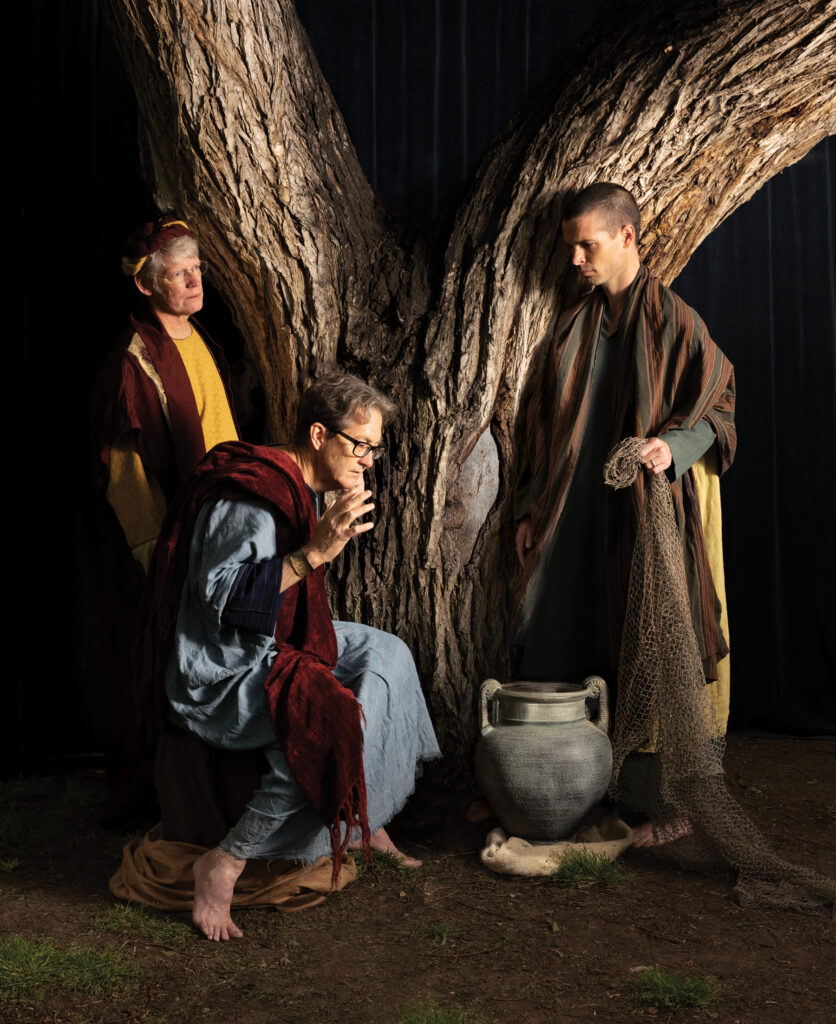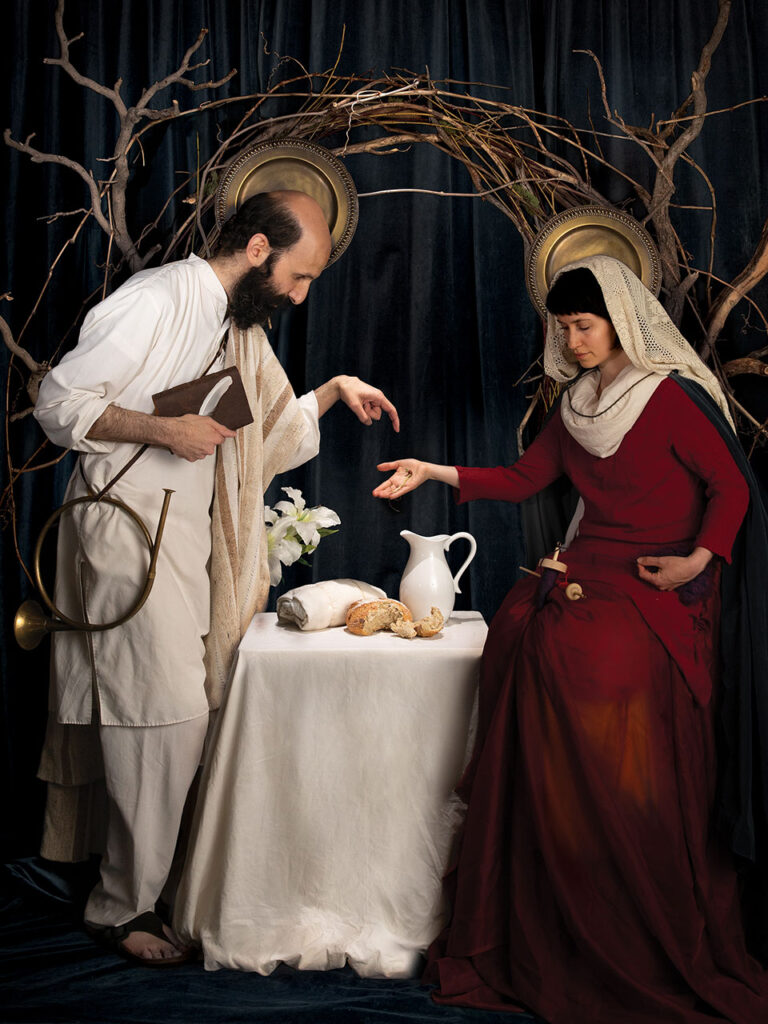We welcome this guest post from Jenny Champoux, Director of the Book of Mormon Art Catalog. You can see much of the work discussed here at https://meganknoblochgeilman.com/about.
A recent insightful article highlighted Megan Knobloch Geilman’s artwork as epitomizing a movement the author labeled “Weird Mormon Art.”[1] Geilman, while fully embracing the strangeness of her art, prefers the term “theological realism.” Her phrase nicely evokes the literary and art style of magical realism, which places fantastical objects or events in a real-world setting. Yet, an important distinction must be made because although Geilman’s work relies on meticulously arranged quotidian objects to create theologically rich scenes, there is nothing fantastic about it. While much of “Weird Mormon Art” is characterized by a kind of tongue-in-cheek playfulness, Geilman’s art is gravely serious. Her work is not peculiar simply for the sake of quirkiness or for anti-status-quo positioning, but instead strives for something more.
Geilman tackles the most fundamental human questions head-on. Her art is informed, questioning, and thoughtful—and always deeply devotional. In this vein, her Symbola Salvatoris series considers the relationship between human beings and God. Each of the eight pieces not only includes a symbol of the Savior but also asks viewers to consider how they can come to know God through their own experiences and devotional practice.
In today’s Latter-day Saint culture, devotional art is typically thought of as that which straightforwardly illustrates scripture stories or principles (think of the images printed in Church manuals or lining meetinghouse hallways). While this method of visualization certainly has its uses, there may be additional ways to think about what it means for art to be “devotional.” The word devotion stems from a Latin root meaning “to vow” or “to consecrate.” To devote is to dedicate oneself entirely and earnestly—religiously, even—to someone or something. The Symbola Salvatoris series suggests that devotional art requires both artist and viewer to fully immerse themselves by slowing down, looking carefully, and thinking deeply. Geilman’s work urges this devotional attitude in at least three ways: a masterful use of formal artistic elements and composition; a dynamic interaction between recognizable models, the artist, and the viewer; and a reinterpretation of traditional western iconography.
First, the composition of each piece cleverly affects the way the viewer perceives it, leading to a frankly devotional reading. Consider the Pietà. The immediate force of it overwhelms the viewer standing before it. The exceptionally large print features the monumental figure of Mary, the mother of Christ. No swooning maiden, this mature Mary is the picture of female power. Her legs, covered in a dark gray skirt, are pushed wide to create a lap that looks more like an altar. The shape of her body exudes pyramidal strength and permanence. And then there is the cutting diagonal of the sheep she cradles. It looks soft and warm and heavy. The material presence of the animal is highlighted by Mary’s fingers half-buried in the wool of its side. But then we notice the blood on those fingers and around the neck of the sheep. In sickening discernment, we realize the blood has even trickled onto Mary’s altar lap. The animal is dead, and newly dead. The rope that led the sheep to slaughter is still coiled by Mary’s foot. It is a devastating image. Geilman’s careful composition of the scene has led us, step by step, to this devotional moment. We contemplate the utter devotion of the Savior, symbolized by the sheep, who laid down His life out of love for us. We consider, in a more physical way, the devotion of His earthly mother, who consecrated her life to helping Him fulfill His mission. Finally, we are brought to a recognition of the devotion that we rightly owe to God. Can we, likewise, consecrate all?

Similarly, the composition of In the Garden, affects how the scene reveals itself to the viewer. By placing the two men in a three-quarter view that obscures their faces, Geilman encourages the viewer to imaginatively enter the scene as a participant. As you do, you might realize that the standing man is not watching for the Savior’s return from an agonizing prayer in Gethsemane but is instead forcefully operating a wine press. Then, you might look closer at the kneeling man and see that he is using a ram’s horn (emblem of priesthood) to catch blood-red grape juice as it seeps out from the winepress. With horror, you might notice for the first time the dribbles of red juice staining the fabric below. This is a messy business. Suddenly, a garden scene that felt familiar and almost peaceful is turned into a nightmare. These men are at once wounding the Savior and relying on his precious blood to save them. Geilman’s skillful positioning of the figures invites you to see yourself as part of the scene. It calls you to recognize your own simultaneous sinfulness and desire for mercy. Ultimately, the scene testifies of the infinite compassion of a Savior who loved the men who nailed him to the cross, even in the moment they did so. As the Savior is devoted to us, so we should be devoted to the Savior.

A second way this series cries for devotion is the complex relationship it creates between the models, the artist, and the viewer. By using recognizable people who are well-known Latter-day Saint scholars and artists, Geilman adds an additional layer of meaning. When we see, for example, BYU biology professor and award-winning fiction writer Steven Peck experiencing an internal vision in Doubting Thomas, it suggests broader tensions between science and religion or between reason and revelation. Or we notice that the casting of Xicana artist and activist Michelle Franzoni Thorley as Mary in Deposition (alongside a crown of barbed wire, a ladder, and a cattle skull) brings in themes of genealogy, racism, and immigration.[2]

Moreover, the way this series uses contemporary, known figures as models creates a sense of beloved community. We see artists, authors, professors, scientists, and activists working together. Their interests and expertise range from poetry and speculative fiction to immigration and environmental stewardship. Some are employed at BYU or the Church History Library. Others work more independently. Despite their differences, in coming together for this series they show their devotion to each other and to the common cause of the Gospel. For a series built around symbols of the Savior, what better symbol is there then this conglomerate picture of, as the apostle Paul puts it, the body of Christ.
Which brings us, finally, to a consideration of how Geilman’s clever use of traditional western iconography heightens the devotional effect of her art. Each of the eight images is centered on a symbol of Christ—a sprouted seed, a slaughtered lamb, a rent veil, the morning star, living water. Geilman again invites the viewer to engage with the art by finding and decoding these and other symbols. The viewer must decipher the symbols and consider the meaning created by the juxtapositions of objects. What do they tell us about the nature of Christ? One thing is clear: these symbolic objects exist here and now in our own world. They have a material presence. How do the figures interact with them? How does this help us consider the ways we might seek the Savior in daily life?
Part of Geilman’s process is studying canonical Western artworks. She draws on medieval Catholic religious iconography, the moralizing themes of Dutch genre painting, postmodern surrealist theory, and everything in between. Reinterpreting these motifs and symbols for Latter-day Saint art opens up surprising connections and new avenues of understanding. In Annunciation the highlighted hand of Gabriel, with pointer finger extended, echoes the hand of Adam in Michelangelo’s Creation of Adam in the Sistine Chapel. Where Gabriel points to the sprouted seed held by Mary, Adam reaches toward the finger of God. In both images, a spark of life is about to be ignited. This parallel visualizes the mercy and love and possibility for new life that is constantly extended to us by the Savior.

Given the role the viewer plays in reading the artwork, Geilman’s images frequently take on unintended layers of meaning. For instance, Woman with the Issue is, for me, strongly evocative of Moses calling on God’s power to stem the tide of the Red Sea. Both this woman and Moses relied on faith, with arms raised heaven-ward, for salvation. While Geilman appreciates and welcomes that connection, it was not intended.[3] This is just one example of how Symbola Salvatoris, as devotional art, presents familiar stories in new ways that allow for multiple interpretations and for personal revelation.
With her carefully composed scenes, familiar models, and symbolic objects Geilman asks the viewer to slow down and spend time looking. Geilman’s artistic process is itself an act of slowness. Each piece takes months of planning, at least a full day of photographing, and then weeks of digital editing. Reading the artist statements, one realizes that creating the work was often a process of discovery and rediscovery. Additionally, Geilman pushed herself to try new technical methods to capture her vision. In the Garden was her first attempt at photographing outside and at night, requiring different processes. Through it all she worked closely with her skillful photographer, Samantha Zauscher.
While the Symbola Salvatoris series is built around New Testament scenes, it encompasses larger themes of doctrine and culture and what it means to be a devoted disciple of Jesus Christ. Geilman presents familiar stories and people and symbols, but packages them in unexpected and exciting new ways causing us to stop and consider again. She isn’t just updating old scenes but is instead calling on the viewer to help create a new dialogue. The sense of frozen sacred stillness in her images urges us to slow down, pay attention, and reconsider what we thought we knew. This is devotional art that compels us to seek the Savior here and now, day by day, line upon line, by study and also by faith.
*****
Jennifer Champoux is the director of the Book of Mormon Art Catalog and an independent scholar of the visual culture of The Church of Jesus Christ of Latter-day Saints. She co-edited Approaching the Tree: Interpreting 1 Nephi 8 (Maxwell Institute). She taught art history as adjunct faculty at Northeastern University and Emerson College.
[1] Ted Bushman and Kristin Perkins, “Embracing the Weird: A New Moment for Latter-day Saint Art,” Center for Latter-day Saint Arts (blog), August 29, 2023, https://themormonartscenter.squarespace.com/the-season-blog-module/2023/8/29/embracing-the-weird-a-new-moment-for-latter-day-saint-art.
[2] The artist notes “A portion of the sales of this piece will go to @raicestexas (chosen by Michelle) which is an organization that works to defend the rights of immigrants and refugees and works [to] reunite families crossing the border.” Instagram post by @megan.knobloch.geilman, July 25, 2022, https://www.instagram.com/p/CgdbDpdrjnz/?hl=en.
[3] Email to author, December 15, 2023.
Comments
Leave a Comment
Be the first to comment.